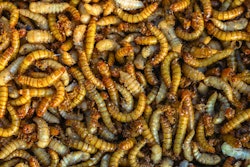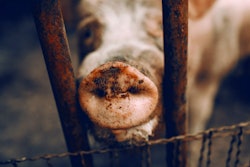
The emergence of African swine fever has triggered growing interest in biosecurity at feed mills around the globe.
line-of-separation-delivery-truck
The yellow feed cart tires in the trailer/box do not cross the line of separation. Product positioned over the line of separation is removed with the green cart and stored in a compartment outside of the truck. Disposable foot protection is put on each time before crossing the line of separation moving from liftgate into truck box. (Courtesy United Animal Health)
Hans van den Heuvel, a 20-year veteran of animal feed quality control, has seen enough animal disease outbreaks to develop an interest in biosecurity. But when African swine fever (ASF) hit China, he knew this time would be different.
“With most animal diseases, there is a light at the end of the tunnel,” said van den Heuvel, quality affairs manager for Trouw Nutrition. “With African swine fever, the light is not that bright.”
Because the virus has no vaccine or cure, he said, preventing it from spreading is imperative. But ASF also persists in the environment longer than other viruses, and recent scientific research suggests it is capable of crossing the ocean in multiple common feed ingredients.
Watching the news from China over the last year has, for feed companies large and small, become a call to action — prompting many to take a hard look at the gaps they need to close to prevent their wares from introducing ASF to new territories or worse, their customers.
Fortunately, experts, feed mill managers and even regulators agree on the same basic steps that need to be taken to prevent the potential feed mill contamination. That’s been leading many company leaders to express optimism that ASF can be brought under control if only they can maintain vigilance.
 Funnel devices are used over the bulk receiving pit to contain product and reduce spillage on the floor. Product spilled on the bulk receiving floor is cleaned up, discarded and not swept in the pit. (Courtesy United Animal Health)
Funnel devices are used over the bulk receiving pit to contain product and reduce spillage on the floor. Product spilled on the bulk receiving floor is cleaned up, discarded and not swept in the pit. (Courtesy United Animal Health)“The Evidence is Growing”
ASF has yet to reach the Americas, but the reality, according to Jaspinder Komal, chief veterinary officer of Canada, is that the “majority of the population is impacted. It’s becoming not only an economic issue, but a food security issue.” And that, Komal said, means that ASF is everyone’s problem.
Rather than waiting to see if the virus would cross the ocean, Komal said Canada began evaluating the risk posed by the virus almost as soon as the news broke that it had jumped from Africa to Asia. It was immediately apparent that the risk of transmission, even to entirely new continents, was high.
“It is a disease that is very sturdy,” he said. “It survives outside of pigs for a long time, in cold weather, in hot weather. It survives on people’s clothes. It survives in pork products. It survives in soil.”
When they started assessing Canada’s ability to control potential pathway by which ASF could be introduced, Komal said, they determined they had good controls for preventing the entry of contaminated meat products. People were another matter, but one they quickly addressed.
Then, there were feed ingredients. On initial inspection, he said, it seemed like they had good controls in place — they already had a permitting system and they didn’t think significant imports came in from countries impacted by ASF. But they soon discovered a hole in their defenses. “It came down to some of the plant-based feed ingredients because we didn’t have a regulatory framework for things like soya or organic corn.”
Because most of the organic grains grown in the U.S. are intended for human consumption, corn and soybeans intended for organic animal feed were coming from China and India, Komal said. They ultimately decided to close the gap by establishing mandatory holding times for plant-based feed ingredients from these regions — the most popular option is to keep the ingredients at 20 degrees Celsius for 20 days.
Feed ingredients are not only a possible but probably source of ASF transmission, according to Megan Niederwerder, an assistant professor of pathobiology at Kansas State University.
Recent research by Niederwerder’s team demonstrated that ASF is capable of surviving a 30-day, trans-oceanic shipment in at least nine common feed ingredients. Other reports, she said, have determined that ASF transmission can occur via the natural consumption of plant-based feed. “We know experimentally that the virus is stable enough in a broad range of ingredients and that it’s capable of transmission through feed,” she said.
While news reports have suggested that the virus is already spreading in animal feed, that is difficult to verify. But “the more we learn about the possibility of this, the evidence is growing.”
 The yellow feed cart tires in the trailer/box do not cross the line of separation. Product positioned over the line of separation is removed with the green cart and stored in a compartment outside of the truck. Disposable foot protection is put on each time before crossing the line of separation moving from liftgate into truck box. (Courtesy United Animal Health)
The yellow feed cart tires in the trailer/box do not cross the line of separation. Product positioned over the line of separation is removed with the green cart and stored in a compartment outside of the truck. Disposable foot protection is put on each time before crossing the line of separation moving from liftgate into truck box. (Courtesy United Animal Health)A new line of defense
At United Animal Health, the realization that ASF could be brought to the U.S. weighed heavily on the mind of quality and regulatory manager Scott Ringger.
“Pigs are an important part of United Animal Health’s past and future growth,” Ringger said. “We have dairy, cattle and poultry sales as well and wanted to focus on what was happening overseas, regarding the detrimental impacts of ASF. We wanted to make sure our biosecurity policies are adequate to protect not just our customers but the entire livestock industry, regardless of the disease status within the U.S.”
However, Ringger said United Animal Health didn’t implement new biosecurity protocol based on perception. They wanted science-based solutions that would have a significant impact on reducing risk and the science points to straightforward, if somewhat unexciting, solutions.
The trick in controlling not just ASF but viral diseases such as PEDV and Seneca Valley is controlling what enters and leaves the feed mill. According to Niederwerder, this means assessing where feed ingredients come from and how they are processed and handled.
“What are the protocols at the manufacturing facility?” Niederwerder said. “Do they use multi-use or single use containers for shipping? Are they stored for a certain period after processing?”
Millers must think about other ways a virus could enter their facility — including their employees and delivery personnel. Because delivery drivers could encounter the virus at the farm, a line of separation should prevent them from entering the mill. When they or other employees do enter the mill, Niederwerder said, they should be required to change their clothes and shoes, or even take a shower before entering the facility.
In addition to reviewing the scientific recommendations, Ringger said United Animal Health swabbed its properties and equipment to test for viruses and bacteria to determine where the greatest risks laid in wait. In the end, they adopted a series of protocols, not unlike the steps Niederwerder’s recommendations. They established “control zone lines” within the facility, which only authorized personnel could cross. Those who do cross the lines must change into dedicated footwear that does not leave the mill or wear disposable boot covers. They began using funnel devices at receiving pits so that incoming products do not spill onto the floor, and anything that does spill is discarded. The company has also established minimum holding times for ingredients imported.
They also focused extensively on their delivery protocol, Ringger said. They’ve worked to establish “lines of separation” at the truck cab and the van box — staff is expected to wear disposable boot covers whenever they cross these lines. A two-cart system was implemented to stop tire movement when transferring product over the line of separation.
Once they established the new protocol, Ringger said, United Animal Health hosted training seminars for all its employees on the whys and wherefores of the new procedures. To assist with the introduction, they collaborated with local experts to talk about the need for biosecurity.
“We included the Indiana Board of Animal Health, a veterinarian and a producer to present information to our staff, get them engaged and help them understand the impacts that a foreign animal disease would have on our country,” Ringger said. “A well-written protocol doesn’t mean much if it’s not followed by all team members. We can’t get that accomplished if we don’t have everyone on board.”
Trouw Nutrition had already implemented measures such as lines of separation and dedicated clothing — even laundry rooms — for mill workers when ASF hit China. But they, too, took additional precautions when the news hit, primarily by auditing the biosecurity practices of their international suppliers.
Viruses like ASF do not exist at the manufacturing site unless brought there, van den Heuvel said. But just giving distributors a checklist of precautions to take doesn’t ensure they’re followed effectively. So, they sent auditors and established monitoring programs to check not only whether ingredient suppliers have biosecurity measures in place but if they understand why and how they work.
 Entryways are marked and secured to protect from unauthorized visitors entering the facility. (Courtesy United Animal Health)
Entryways are marked and secured to protect from unauthorized visitors entering the facility. (Courtesy United Animal Health)Light at the end of the tunnel
While these measures may seem temporary or disease-specific, van den Heuvel believes they’re here to say for the long term —years, if not decades.
Van den Heuvel said he felt confident that Trouw Nutrition can keep ASF at bay. However, until a vaccine or another means of controlling the virus is developed, preventing it from gaining new ground will require constant vigilance. The greatest threat, he said, may be the potential for the industry to grow accustomed to the virus’ presence.
“It needs constant attention and people need to be constantly brought up to awareness,” van den Heuvel said, “because otherwise, it gets sloppy.”
Komal agreed, saying that perhaps the most important preventative measure of all is to maintain ASF as a topic of conversation. “Every day, I wake up and say: ‘good, we still don’t have ASF,’” he said. “Having said that, I continue to say it’s imminent. I would be breathing sigh of relief if a few countries were able to say we’ve been able to eradicate the disease, but… there is no end in sight. As long as the virus continues to spread, we have imminent danger of it coming here.”
Yet even if the virus were contained, Ringger said he believes the industry’s heightened biosecurity is here to stay. More people travel, more business conducted internationally and the awareness that a new viral threat could appear at any moment looms.
“It’s a changing world, and this is something that is very important,” Ringger said. “At the end of the day, if we don’t protect ourselves, if we don’t protect our customers, we could face many challenges within the agricultural industry.”















